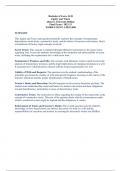Bachelor of Laws, LLB
Equity and Trusts
Queen’s University Belfast
Final Exam - 2022-23
WORD COUNT: 2,983/3,000
SUMMARY
This Equity and Trust exam question primarily explores the concepts of testamentary
dispositions, secret trusts, constructive trusts, and the duties of executors and trustees. Here's
a breakdown of the key legal concepts involved:
Secret Trusts: This concept is explored through Michael's instructions to his sister, Ciara,
regarding Jane. It tests the student's knowledge of the formation and enforceability of secret
trusts, including the requirements for a valid secret trust.
Testamentary Promises and Gifts: The scenario with Michael's Cartier watch involves the
analysis of testamentary promises and the legal implications of changing intentions in a will.
It examines how verbal promises interact with the formal requirements of a will.
Validity of Wills and Bequests: The question tests the student's understanding of the
principles governing the validity of wills and specific bequests, focusing on the clarity of the
testator's intentions and the proper identification of beneficiaries.
Trustee's Duties and Discretion: David's bequests involve trustee discretion and duty. The
student must understand the extent and limits of a trustee's discretion and their obligations
towards beneficiaries, particularly in cases of discretionary trusts.
Constructive Trusts: The instruction to Mona regarding the residue of the estate hints at the
concept of constructive trusts. This part of the question deals with the circumstances under
which a constructive trust might be implied and the obligations it creates.
Enforcement of Trusts and Executor's Duties: The overall question tests the student's
knowledge on how beneficiaries can enforce the terms of a trust or a will and the
responsibilities of executors and trustees in ensuring the deceased's wishes are fulfilled.
, EXAM SCENARIO
Michael lived with his wife, Kate, and their only daughter, Siobhán. In November 2019,
Michael received the unfortunate news that he was terminally ill. Only days later, he
arranged to meet with his sister, Ciara, and informed her that he had an affair for the past
five years with Jane. Michael assured Jane that Ciara would ensure that she was properly
looked after. During his meeting with Ciara, he provided her with a sealed envelope with
instructions. Ciara opened the envelope only hours after Michael left and it simply stated:
“All that I give to you, you must give to Jane”.
In early January 2020, Michael advised his old friend, Frank, that in his will he would leave
him his Cartier watch. Michael later informed his wife that he wanted Frank to have his
Cartier watch because he had always admired it so much.
Later that month Michael died. In his will, Michael made the following bequests:
• £150,000 in cash to my sister Ciara; and
• My limited edition Cartier watch to my wife, Kate, because she will know how to
dispose of it; and
• All the rest and the residue of my estate to my wife Ciara and daughter Siobhán in
equal shares.
In March 2020, Michael’s brother, David died. He specialised in demolition and had built up
his demolition company to include a number of assets. In his will he made the following
bequests:
• I leave the bulk of £600,000 in cash to my nephew Nigel, who shall be trustee. It is
my wish that Nigel distributes it between my two children, Brendan and Joseph as
he sees fit. In the meantime, he may pay a reasonable income from the investment
of the money to any of my employees, but may consider those who have worked
the longest for me as being the most deserving;
• I leave the newest of my machinery assets to my nephew Nigel on trust for my
nephew Patrick, who has shown a particular interest in demolition and who I know
will make good use of this machinery when he turns 18; and
• The residue of my estate to my wife, Mona, for her sole use and benefit in the full
confidence that she will act fairly and reasonably to our two boys in sharing out the
same to them when it is no longer required by her.
Advise as to the validity of these dispositions and whether they can enforce performance.




